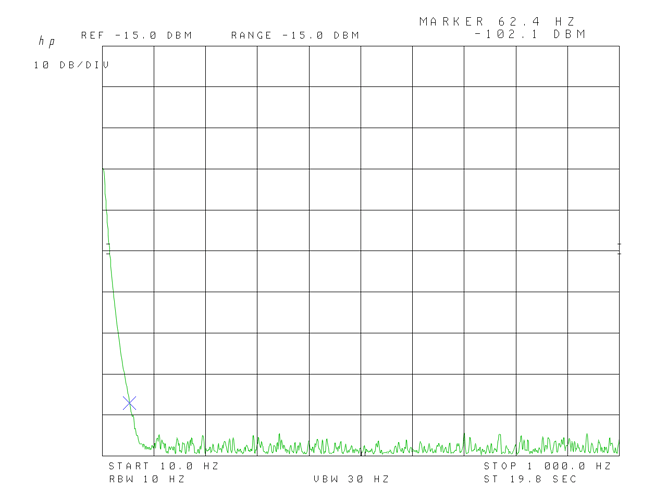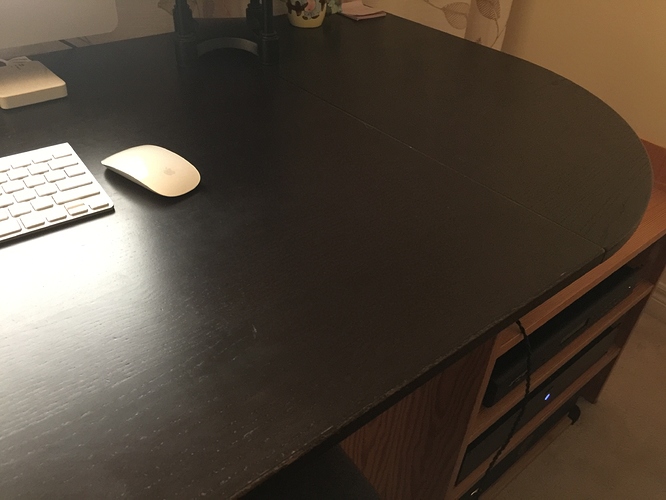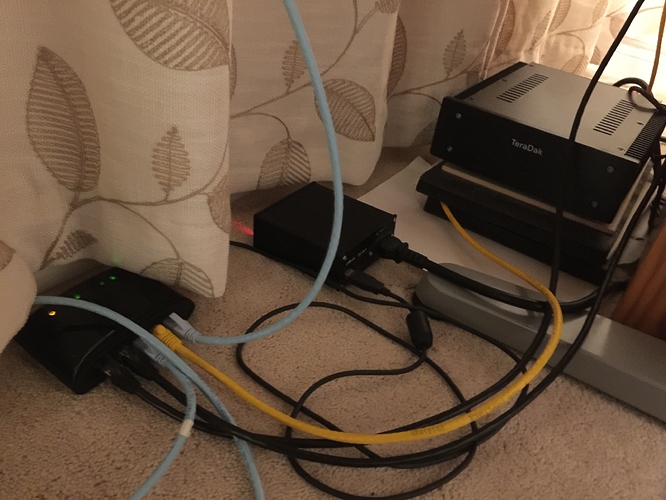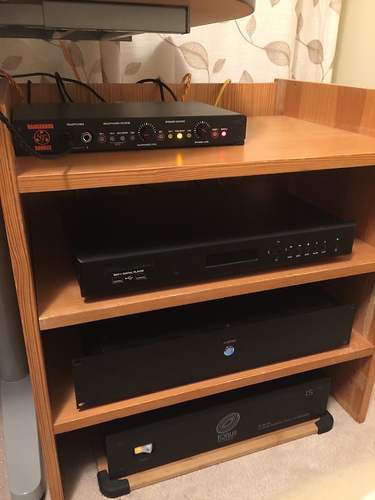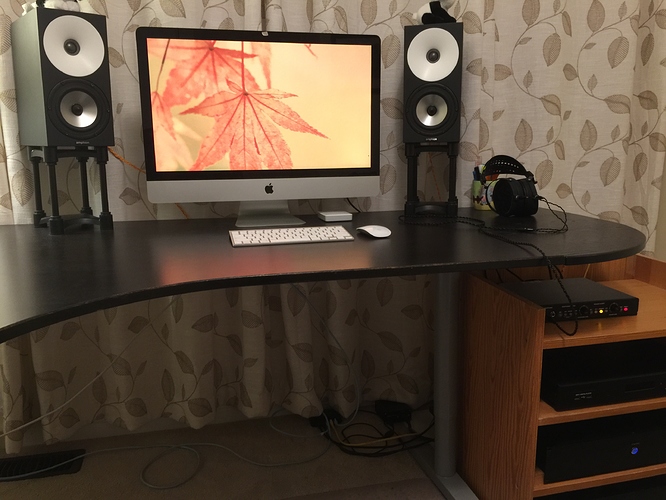The old ‘Blackberry near a speaker’ party trick (while an extreme example) is one that suggests airborne RFI can affect sound quality.
Ya, it suggest a BLACKBERRY near a speaker can effect SQ. And I don’t think it was Blackberry, it was NexTel PTT phones.
You have an old blackberry or NexTel PTT phone handy? I’ve had the Nextel PTT so I know what is being talked about. It’s plainly apparent what RFI sounded like in that case.
Hmmm I don’t have my old BlackBerry Bold sadly, although I have a BlackBerry Classic lying around somewhere !
I’ve also heard buzzing with my iPhone plugged into (and near) USB DACs…
Anyway it’s all rather interesting.
To keep things on a friendly note (and hopefully something everyone can agree on) we can still very much enjoy music without going over the top, whether using just stock basic ethernet cables or using WiFi to stream around the house.
I hope you are starting to see a pattern wrt interference and proximity… Read Siemens “The Antenna Myth” as they go into this.
As long as the Ethernet Cable is working, data is exactly the same, but bad constructed cable will have more bad data blocks hence more resend and reduce the effective bandwidth, and all kinds of metal cable connection was under influence of picking up or transmitting noise from another end to the end of audio playback, even digital system have higher immunity to noise but unlucky just like DAC that’s both Analog and Digital in single box, ground noise from Ethernet associated equipment can pass along to audio gear and contaminate the analog signal, so a well constructed Ethernet not enhancing the audio quality but just lower the noise floor, sublet details may reveal without low level noise masking effect.
I use and offer both wired and WIFI interfaces. The WIFI interface sounds identical to the optimized wired interface (grounded LPS on the router). I don’t experience any difference in audio quality. In fact, I recommend to use my WIFI rather than wired, because with wired, I don’t have any control over what router and what power supply the customer uses. With WIFI, I control everything, so I can better guarantee best SQ. This is what I want reviewers to use as well. Fewer unknowns is better.
Steve N.
This buzzing was likely due to ground-loops picking up the RFI. Without ground-loops, it probably would not happen. I don’t have any ground-loops and I don’t get any of this.
Steve N.
Empirical Audio
Read this thread. Leakage currents are reduced by earth-grounding the router power supply and using a LPS rather than a SMPS.
It audibly reduced background audio noise in my system when I grounded the router, and I have no ground-loops in my system to start with.
Steve N.
Empirical Audio
My main switch is a Cisco Catalyst 3560 and has a 3 prong IEC receptacle So I’m certainly chassis grounded. Using Arta and the RME UFX loopback my noise floor is ~133db and I’m seeing little mains noise when zoomed waaaay in.
As you said it’s not how much you spend but what you spend it on.
Here is a graph with a popular MeanWell SMPS with a strap tying IEC earth:
But again, my point is that a $700 Ethernet will transfer the leakage current same as a $7 cable. Technically if the $700 is made of silver it would make things worse due to Silvers marginally better conductivity. So maybe if someone hears a difference with a $700 cable, what they are actually liking is NOISE.
I can attest to the effectiveness of Steve’s Final Drive buffers. I have ground loop problems in my listening room (equipment in my closet is on a different circuit than the amp & subs in my listening room) and the Final Drives cleared the problem right up. So well, in fact, that I got another pair just for the subs.
Ethernet is already an isolated interface. To induce mains leakage into it, I had to really go to town and wrap my AC mains and Ethernet cables together. Even then, the peak mains contribution was at a whopping -119 dbFS. See my measurements here: https://audiosciencereview.com/forum/index.php?threads/review-and-measurements-of-emo-en-60kds-ethernet-isolator.1869/
Any notion of power supply from a router/switch causing this kind of leakage and having it be audible makes for an impossible case! 
So the bottom line is, if a hard core “subjectivist” claims to hear a difference between generic and “audiophile” Ethernet cables, but nobody (so far) has been able to demonstrate he does in a blind context, and nobody (so far) has been able to come up with a physical model or measurements that would explain the difference, the explanation that best satisfies Ocom’s razor is the subjectivist is deluded.
I wouldn’t say deluded as the brain can play very clever tricks. There are such things as Expectaion Bias and the Placebo effect. These things are very real, they use Placebo in medicine.
Hey, if it works, it works.
The human brain is far from a pacife receiver of data.
I have done an extensive blind test between three audiophile cables.
There was no difference in sound quality at all. Tried really hard. But I had a high expectation bias they don’t make a difference so it might be placebo and the differences are actually huge in reality. I will never know. Or my ears just need another ten years of training.
All kidding aside. Even if I pull the cable out the song keeps on playing and sounds no different. In some situations this can make a difference, and yes I have heard that happen. That’s the very first test you should do because this reveals any grounding problems you might have. Solve these first by using UTP instead of STP cable. Otherwise you might end up buying hundreds of dollars worth of cables or isolators just to fix a grounding problem.
Other then that I would spent my money on real Vodka instead on a cable I tested with that name on it.
Amen to that. And the more you partake the less difference it makes, or at least the less believable the differences claimed.
By the same principle, save the premium stuff for the first few shots, after that any swill will do. 
Placebos in medicine are verifiable effects, as in a disease getting better even though what was administered was a placebo. But what we hear? It goes back to the Firesign Theater dude.
I have been doing back and forth comparisons for some time now between my Cat 6 UTP and 6a S/STP with the ground connected only at one end (BDP-1). Both are around 5-6 feet. As mentioned earlier in the thread, the switch is D-Link DGS-1005 (unshielded) and powered by a Teradak LPS which is plugged into a Torus. One Cat 6 UTP connection to iMac, other to BDP-1 (variable), and one CAT6 UTP to router.
I’ve put the router and it’s switching power supply about 8 feet away from the audio rack. The router isn’t connected to the internet, so the only traffic in the switch is from Roon and BDP-1. Nothing else connected to the switch. Sometimes, I’ll even unplug the router and it’s power supply to take that component out of the equation completely. So the entire traffic will be on one switch with two 5 feet cables. This way, I control things.
Unfortunately, the one noisy thing that I do in have in the area is a 2009 27" iMac (w/ bluetooth mice and keyboard), which is around a meter away from the rack. The 2009 model has the highest power consumption of the recent iMac series as well based on Apple’s specs. I have brought a AM radio previously to check for interference, into the vicinity of each of my components individually powered one at a time, and the iMac was by far the worst. It has a huge throw.
Mark Brown previously made a good point about doing a simple experiment: “Does the sound change if the ethernet cable is pulled?”…unfortunately, that simply is not possible with Roon and BDP-1. There is constant network traffic at all times and if the ethernet cable is pulled, the music stops almost immediately.
Regarding blind testing, in my setup, the way I have my desk and rack placed, I actually cannot see which cable I’m grabbing unless I get off the chair and crawl down. My desk blocks my vision completely. I’ll have the UTP and STP in the back of the rack and I’ll grab one and just try to put it inside the ethernet port of the BDP-1 and try and figure it out. I’ll upload some pics so you can understand better. One is from my perspective at head height. I can’t tell which one is which.
I do have a semi-concrete opinion of how the sound differs between the two in certain aspects. I won’t make comments on which one sounds better or will be preferable. From time to time, I have moments where I like one more than the other. I think I’m slowly figuring out why my preferences sometimes reverse with particular recordings. Initially, I thought I was going crazy and my mind was playing tricks on me. However, no I do have an idea in mind. I’ll leave the subjective descriptive stuff out for now.
The only thing that I thing I can with confidence is that I do find the SSTP ‘quieter’ than the UTP. I’ve noticed this time and time again. Ever since I got them, the first thing I did was to turn up the volume.
I’ve looked quite a bit, and there have been only a handful of people who’ve made similar comments about the shielded cables coming off as ‘quieter’ or giving the impression that the music seemed quieter.
For me, this was the first time somebody else had made a comment about a difference in ‘volume’:
Cookie Marenco: http://dsd-guide.com/can-ethernet-cables-makes-difference-we-test-find-out
Fascinating stuff.
From almost 10 years ago. One of the Linn’s staff (krisweir) comment about shielding. Some of it is similar to what two of the Roon (one former Meridian) guys have said before:
https://forums.linn.co.uk/bb/showthread.php?tid=1278
One thing worth considering is using screened (i.e. FTP) Cat5 cable. This will connect the screen to mains ground at the DS. (The other end is unlikely to be grounded, as very few domestic switches or routers have a grounded chassis, so should be no potential ground-loops through the network cable.)
The will minimise any digital RF noise leakage from the data network cabling into the audio circuitry, which can only help.
If you do have a grounded network switch or router, and want to isolate the FTP screen at that end, you can just use a short UTP patch-lead and a (FtoF RJ45) Cat5 connector at the switch.
…Not normally needed for digital reasons - unless you like doing arc-welding in your house - but can be useful for screening RF noise pickup. Here its purpose is not so much to stop noise getting in to the ethernet as stopping noise leaking out, and possibly into analog interconnects, etc.
I just re-read that comment again above from that Linn guy. This one in particular:
The will minimise any digital RF noise leakage from the data network cabling into the audio circuitry, which can only help.
What if the whole time this was the issue. Not any noise from the surroundings getting inside the cable, but rather RF getting out from the ethernet cable at the connection point and specifically affecting the circuitry inside the chassis? This could make sense since RAAT is constantly transmitting non-stop and the ethernet ports are constantly active.
That might be why people notice a certain character with shielded and unshielded cables. With unshieded cables, you might have constant RF leakage. With the shielded cables, there might be less leakage affecting the components within the chassis?
The Siemons paper would support this as well: https://www.siemon.com/us/standards/Screened_and_Shielded_Guide_7_Antenna_Myth.asp
Any thoughts?
Are you certain about that switch not having shield connections? D-Link shows renderings on their site which makes it look like it has fully plastic connectors. At the same time there are photos floating around which show metal connector housings (which would have a shield connection). Or it could be like some of the Apple products that have two little metal bumps inside the connector housing that provide a shield connection.
Regardless, if it does have a shield connection you are now connecting the ground plane of that switch to the ground plane of your audio device. In some cases I’ve seen installations where the entire network (all using two prong “wall wart” type power supplies) was grounded to the audio system as the customer insisted on using shielded cable.
If the power supply you’re using connects earth to the outer ring of the power plug then you have potential for a ground loop.
Even if the switch has no shield connection (which would be ideal) you’d still end up with a relatively long RF antenna connected to the ground plane of your audio component and I can’t imagine anyone thinking that’s a good idea.
The comment about using an RJ45 gender changer to attach a pigtail seems like a good idea on the surface and is a potentially bad one in practice. I’ve used these devices in the past and some of them won’t properly interconnect all 8 conductors. With gigabit you’ll still get a link, but traffic flow is compromised. Beyond that you have to be sure that the terminations meet the standards for whatever category cable is in use and this is much easier said than done. No network engineer worth his salt would ever condone using one of these.
In networked audio, especially when sound quality is involved shielded network cables can be way more trouble than they’re worth.
